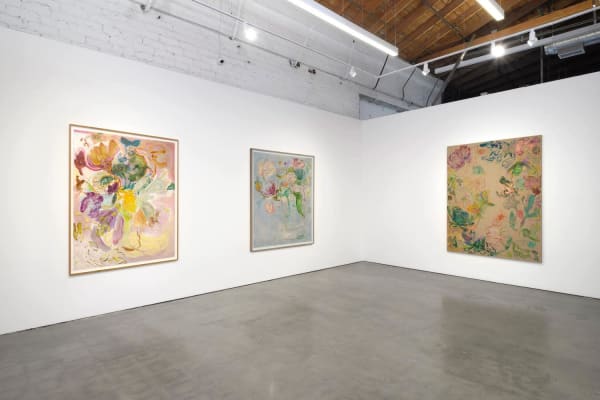Patricia Iglesias Peco: Naturaleza Viva
“At least at first glance, and in general: in fact, most flowers are badly developed and are barely distinguishable from foliage; some of them are even unpleasant, if not hideous… Other flowers, it is true, present very well-developed and undeniably elegant stamens, but appealing again to common sense, it becomes clear on close examination that this elegance is rather satanic: thus certain kinds of fat orchids, plants so shady that one is tempted to attribute to them the most troubling of human perversions… In fact, after a very short period of glory, the marvelous corolla rots indecently in the sun, thus becoming, for the plant, a garish withering…”
– Georges Bataille, The Language of Flowers, 1929.
François Ghebaly Los Angeles is proud to present Naturaleza Viva by Patricia Iglesias Peco, the artist’s first solo exhibition at the gallery. Iglesias Peco’s mystical floral oil paintings express the vulgar, monstrously ecstatic abandonment of plant life.
Flowers can be quickly dismissed as superficial presentations of obligatory affection, often symbolizing saccharine emotions like “Love” or “Joy”, “Congratulations” or “Condolences”. In the last century, artistic renderings of magnified stamens and pistils have given rise to more mainstream associations drawn between unfurling petals and sexuality, elevating more conventional readings of flowers to a more psychoanalytical prerogative. In her essay, “Bad Flowers” Jamieson Webster succinctly states, “flowers are literally the genitals of plants.” While flowers are enticingly-pigmented, arousingly fragrant, vibrant, and virile, their life spans are short. In Naturaleza Viva, Iglesias Peco considers flowers’ ephemeral sexual lives and emphasizes their primal urgency and aggression.
Gesturally painted in harmonious colors with sharp, saturated punctuations, Iglesias Peco’s plant life, despite their impending death, is rife with clandestine botanical activity. Her long sweeping gestures, liberal use of watery oil paint, and shorter, bellicose brushstrokes present climactic conversations between reproducing plant bodies. Especially popular amongst early-1600s Dutch and Flemish societies, floral still-lifes have a longstanding presence in art history. Beyond subject and symbolism, Iglesias Peco’s flowers move. Radiant, rich, and juicy, her paintings convey the sensual dance between filaments and sticky stigmas receptive to pollen. Imaginations of floral scents waft in the air, hovering around each painting but still, a mysterious darkness charges each work. Deeper color tones suggest withering, dehydration, or sun-sick leaves but even these tones are merely interspersed. Ecstasy is central.
Bataille writes, “It is impossible to exaggerate the tragicomic oppositions indicated in the course of this death drama, endlessly played out between earth and sky.” Iglesias Peco’s works do not ignore a precious flower’s inevitable end. In defiance of death, Iglesias Peco’s works capture fluorescence, in all its fleeting yet tantalizing glory. Thrusting viewers into an entanglement with petals, stems, thorns – all flowers’ sexual organs – Naturaleza Viva celebrates life, cultivates beauty, and embraces intense, peak pleasure.
Patricia Iglesias Peco (b. 1974, Buenos Aires, Argentina) lives and works in Los Angeles, California. After apprenticeships with Pablo Edelstein and Philip Pavia, in Argentina and Italy respectively, Iglesias Peco moved to the United States to study first at the Savannah College of Art and Design and subsequently at the School of Visual Arts in New York. Iglesias Peco has participated in several group and solo shows, both in the United States and Argentina including: Del Vaz Projects, Los Angeles; Situations, New York; La Loma Projects, Los Angeles; Barbara Gladstone, New York; Sears-Peyton, and Soloway Gallery, New York. She currently lives and works in Los Angeles.









